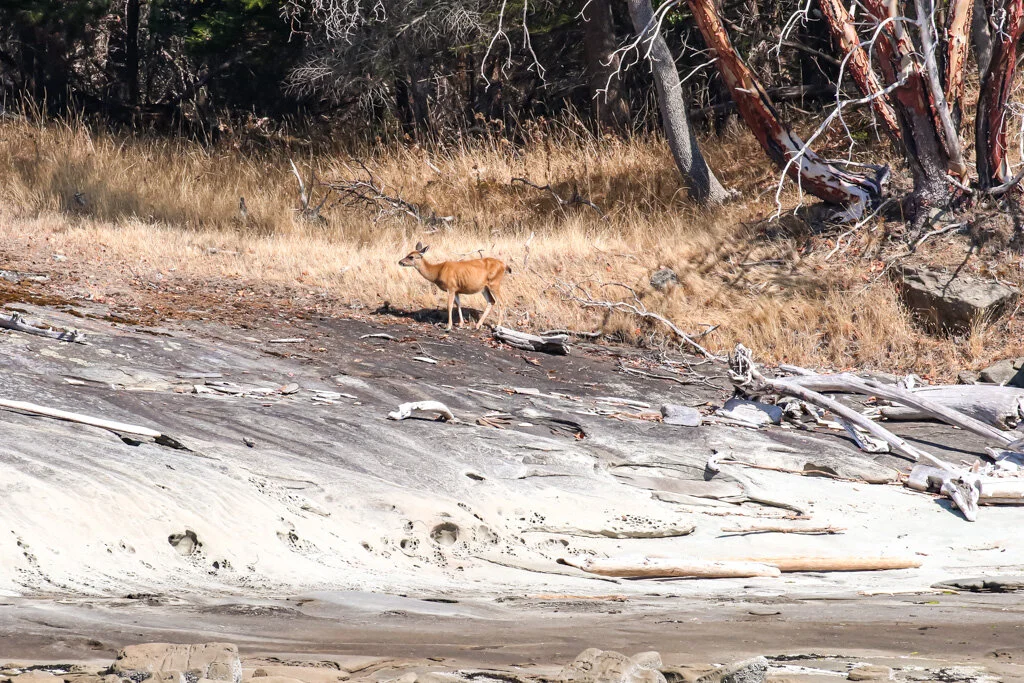August 23rd - Orcas in the morning and humpbacks in the afternoon
On August 23rd, our open boat Cascadia found a pod of 5 orcas near Gabriola Passage. The pod we found here were the T37A’s! The T37A’s are made up of Volker (T37A) and her children Inyo (T37A1), Inky (T37A2), Spinnaker (T37A3), Crinkle (T37A4) and T37A5. Inyo doesn't always travel with their pod. Volker is the matriarch of this pod and she is 27 years old. Her children’s ages are;
Inyo: 14
Inky: 12
Spinnaker: 9
Crinkle: 6
T37A5: 2
Orcas can have a long lifespan. Females typically live 60-80 years while males live 40-60 years. Females can have their first calves at 12-14 years of age and have a gestation of 15-18 months. Females typically produce 5 surviving calves over their reproductive 25 years. Females typically have calves every 3-5 years. When females reach the age of 40, they go through menopause and cannot reproduce anymore. Volker is just 27 years old but she’s already had 5 surviving calves. Males typically reach full maturity at 20 years of age but are able to reproduce at 15 years old. Males are larger than females and will develop huge 6 feet long dorsal fins by the time they are 20 years old.
The T37A’s were very active as we watched them hunt. Transient killer whales feed on marine mammals where most of their diet consists of harbour seals. They can also eat Stellar sea lions, harbour and Dall’s porpoises and sometimes Humpback and Grey whale calves. Transient killer whales will hunt together and share their meals together. During their hunt, we saw one of the killer whales breach out of the water! They are more vocal than usual when they’re catching their prey as they no longer have to remain stealthy and they will talk more and be more active during a hunt.
For our afternoon tour, we found two humpback whales near Texada Island. Europa and her calf were the two humpbacks we saw that were travelling. Humpbacks migrate here from Hawaii around April and will remain here until the end of November to feed. The waters here are very nutrient rich during these months and they can find lots of krill and small fish to eat during this time. They will eat close to 3000 pounds of food per day while they’re here to bulk up before they go back to Hawaii or Mexico which are their breeding grounds.
There are quite a few mother-calf pairs that can be found in the Salish sea at this time of year. Moms will nurse their calves for 6 months to about a year. Calves often start feeding independently at 6 months of age. Humpback moms are known to be very tentative as they keep their calves close to them as often as possible where the calf will often be riding the moms head or rubbing up against her belly or chin. They will sometimes stroke their calves gently by touching their face, pecs and body with their pectoral fins. During our time with these two humpbacks, we saw them fluking and saw a chin slap as well!
Check out the photos our naturalists took below!
Photo by Cheyenne Brewster, 10:30am
Photo by Cheyenne Brewster, 10:30am
Photo by Cheyenne Brewster, 10:30am
Photo by Cheyenne Brewster, 10:30am
Photo by Cheyenne Brewster, 10:30am
Photo by Cheyenne Brewster, 10:30am
Photo by Cheyenne Brewster, 10:30am
Photo by Cheyenne Brewster, 10:30am
Photo by Cheyenne Brewster, 10:30am
Photo by Cheyenne Brewster, 10:30am
Photo by Cheyenne Brewster, 10:30am
Photo by Cheyenne Brewster, 10:30am
Photo by Cheyenne Brewster, 10:30am
Photo by Cheyenne Brewster, 3:30pm
Photo by Cheyenne Brewster, 3:30pm
Photo by Cheyenne Brewster, 3:30pm
Photo by Cheyenne Brewster, 3:30pm
Photo by Cheyenne Brewster, 3:30pm
Photo by Cheyenne Brewster, 3:30pm
Photo by Rebecca Stirling, 3:30pm
Photo by Rebecca Stirling, 3:30pm
Photo by Rebecca Stirling, 3:30pm
Photo by Rebecca Stirling, 3:30pm
Photo by Rebecca Stirling, 3:30pm
Photo by Rebecca Stirling, 3:30pm
Photo by Rebecca Stirling, 3:30pm
Photo by Rebecca Stirling, 3:30pm
Photo by Rebecca Stirling, 3:30pm
Photo by Rebecca Stirling, 3:30pm





























